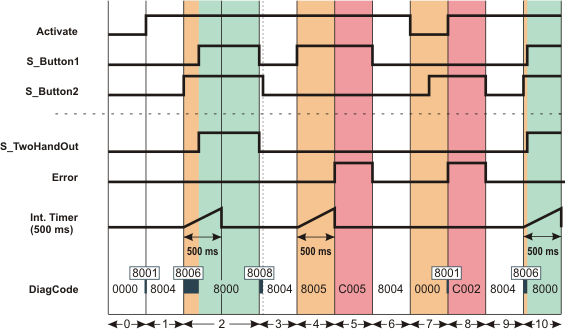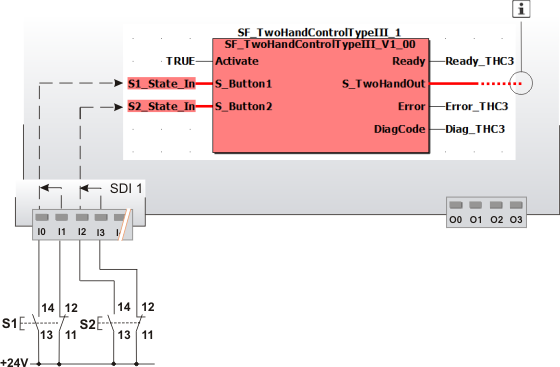SF_TwoHandControlTypeIII
The following description is valid for the function block SF_TwoHandControlTypeIII_V1_0z, Version 1.0z (where z = 0 to 9).
Short description
|
The safety-related SF_TwoHandControlTypeIII function block evaluates the switching behavior of a type III two-hand control device connected to the Safety Logic Controller. This involves evaluating the switching states of both the buttons on the two-hand control device. The S_TwoHandOut output only becomes SAFETRUE if both inputs switch from SAFEFALSE to SAFETRUE within 500 ms, either simultaneously or consecutively (if both buttons on the two-hand control device are pressed after being not actuated before). |
|
The used type III two-hand control device must comply with the requirements set out by EN 574.
Unlike the type III two-hand control device described here, evaluation by the type II version takes place without consideration of a specific duration within which both buttons must be actuated.
Function block inputs
Click the corresponding hyperlinks to obtain detailed information on the items below.
|
Name |
Short description |
Value |
|---|---|---|
|
State-controlled input for activating the function block. Data type: BOOL Initial value: FALSE
NOTE:
While function block activation is taking place (with input Activate = TRUE), both inputs must show the SAFEFALSE state. This means that none of the buttons on the two-hand control device must be actuated. Otherwise, the function block detects this as an error (output Error = TRUE). |
|
|
|
State-controlled inputs for evaluating the connected two-hand control device. Data type: SAFEBOOL Initial value: SAFEFALSE |
|
Function block outputs
|
Name |
Short description |
Value |
|---|---|---|
|
Output for signaling "Function block activated/not activated". Data type: BOOL |
|
|
|
Control signal for stopping (stop request) or starting and maintaining machine operation. Data type: SAFEBOOL |
|
|
|
Output for error message. Data type: BOOL |
|
|
|
Output for diagnostic message. Data type: WORD |
Diagnostic message of the function block. The possible values are listed and described in the topic "Diagnostic codes". |
Signal sequence diagram
This diagram is based on a typical type III two-hand control application.
The signal sequence diagrams in this documentation possibly omit particular diagnostic codes. For example, a diagnostic code is possibly not shown if the related function block state is a temporary transition state and only active for one cycle of the Safety Logic Controller.
Only typical input signal combinations are illustrated. Other signal combinations are possible.

|
0 |
The function block is not yet activated (Activate = FALSE). As a result, all outputs are FALSE or SAFEFALSE. |
|
1 |
Function block activated by Activate = TRUE. At this point, the two buttons are not actuated (S_Button1 and S_Button2 = SAFEFALSE). Both inputs must be SAFEFALSE during activation of the function block, so the Error output remains FALSE. |
|
2 |
Button 2 (on S_Button2) is actuated, which starts the monitoring time. Button 1 is also pressed within the required period of 500 ms. When S_Button1 switches to SAFETRUE, the condition for two-hand control is met and the S_TwoHandOut output becomes SAFETRUE. |
|
3 |
The S_TwoHandOut output becomes SAFEFALSE, as S_Button1 and S_Button2 switch to SAFEFALSE within a short time of each other (buttons are released). |
|
4 |
The button on S_Button1 is now actuated again. The monitoring time begins. |
|
5 |
Monitoring time runs without button 2 having been pressed. Therefore, the S_TwoHandOut output remains in the defined safe state SAFEFALSE and an error is displayed at the Error output as a result of the TRUE status. |
|
6 |
Button 1 is released again, which means that the SAFEFALSE state is now present at both inputs. This causes the error message at Error to be reset: Error becomes FALSE. |
|
7 |
The function block is deactivated: Activate switches to FALSE. Button 2 is pressed while the function block is inactive. This change in state does not start the monitoring time, however, as the function block has not been activated. |
|
8 |
Function block is activated again (Activate becomes TRUE again). The signal combination at the inputs (S_Button1 = SAFEFALSE and S_Button2 = SAFETRUE) at the time when the function block is activated again leads to an error message (Error = TRUE, S_TwoHandOut = SAFEFALSE). Both inputs must be SAFEFALSE when the function block is being activated. |
|
9 |
The error message is "reset", as S_Button1 and S_Button2 are now in the SAFEFALSE state (neither button is actuated). |
|
10 |
Both buttons are actuated again (within a period of 500 ms), the condition for two-hand control is fulfilled, and S_TwoHandOut switches to SAFETRUE again. |
Application example
This example shows the connection of a type III two-hand control device with the safety-related SF_TwoHandControlTypeIII function block.
Each of the two buttons has both an N/C and an N/O contact and is connected to safety-related input device SDI 1 via a two-channel arrangement.
The two resulting signals monitored for antivalence are each assigned to global I/O variables and connected to the function block inputs S_Button1 and S_Button2 for evaluation
The details and notes for this application example must also be taken into account.
The S_TwoHandOut enable output of the SF_TwoHandControlTypeIII function block is connected to an output terminal of the application, either directly or via other safety-related functions/function blocks.
Connect the S_TwoHandOut enable output of the SF_TwoHandControlTypeIII function block to the S_OutControl input of the EDM function block, for example, thus implementing a two-channel output connection.
For more detailed information, refer to the description of the corresponding safety-related function block.

|
S1 |
Button 1 |
|
S2 |
Button 2 |
|
|
See note above the illustration. |
Detailed information
Additional information is available in the following sections:
